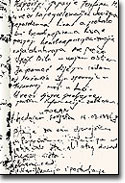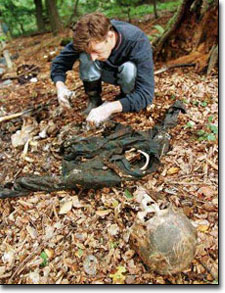


Stage 2 - Visits Graves
Related IssueForensics: Investigating Human Rights
The American Heritage Dictionary defines "forensics" as "the use of science and technology to investigate and establish facts in criminal or civil courts of law." The term has become more common in human rights investigations. As journalists assume a growing role in reporting human rights violations, they need to acquire a more concrete sense of what constitutes reliable - and admissible - evidence. Stories built on rushed, poorly reported, or second-hand evidence are more susceptible to challenges and political attack.
Investigating human rights violations has many techniques in common with investigating other crimes. But while a U.S. crime reporter may have access to police, special investigators and a highly developed judiciary system, international reporters often operate in a legal vacuum - or within a legal system that conspires to hide evidence of an official abuse.
If a journalist is among the first to arrive at the scene of an abuse, he should take pains to observe and document as much physical evidence as possible.

Found at Sahanici grave: two handkerchiefs, a comb. On Rohde's notebook, a survivor drew a sketch of a nearby gym used to hold victims. Photo: Christian Science Monitor
It is useful for even print reporters to travel routinely with a camera and to know how to take serviceable pictures. Photos do not constitute infallible evidence, but they help, and can be valuable for later interpretation or an aide memoire. Physical evidence of violence may include traditional elements, like bones and bloodstains. But in some instances, items like shell casings, papers, or pieces of clothing can be equally crucial. It is also important to absorb and convey a sense of the context of the scene - what is the surrounding area like? Where are the access roads?
In most situations, one should not disturb physical evidence. (In the case of Srebrenica, however, David Rohde had reason to believe that those who came after him would seek to destroy evidence. Therefore it made sense for him to take items like documents and pieces of clothing with him for further analysis.) See map.
Few stories -- or legal cases -- rest on physical evidence alone. Often the evidence cannot be interpreted without interviews with possible witnesses or others familiar with details of the events. Journalists should also seek expert advice at an early stage. They are not expected to be experts in all fields, but rather to identify and reach experts who can reliably interpret the evidence at hand. For example, DNA tests conducted on a murdered child might determine his living relatives or parents. Examination of bones or skulls may also determine what weapons were used, or the capability of perpetrators.

Town meeting notes found by Rohde at a gravesite in August were identified as belonging to missing men from Srebrenica. Photo: Christian Science Monitor
"As long as there are pieces of a body, forensics can be used to make out a case of what happened, when it happened, the identity and age of the victims and how they were killed, " says Nathaniel Raymond, spokesperson for the Boston-based Physicians for Human Rights (PHR).
Founded in 1986, PHR has conducted medical investigations of human rights violations in over 50 countries. It is one of the many reservoirs of expertise that journalists can use to interpret findings on the ground. Journalists must also seek the following experts: pathologists for physical torture, psychiatrists for mental torture; ballistic or military experts for ammunitions and firearms; scientists and non-governmental workers for historical context.

A war crimes investigator, from Tuzla, reconstructs the body of a man killed in the hills of Kravice in September 1996. Photo: AP
"Your job is to present the facts. It is up to the courts to determine guilt," says Paul Martin of the Columbia University Human Rights Clinic. "Report on the debates as to whether a crime has happened and leave it to the public to judge."
To inform one's reporting, it is important to have working knowledge of humanitarian law and the institutions of justice.
The process of reporting human rights abuses generally takes this sequence:
1. Journalist hears rumor or learns of an event in which a violation of human rights may have occurred.
2. Journalist conducts preliminary inquiries to verify information on Internet or other means.
3. Journalist visits scene of crime to interview witnesses and people with relevant information or positions on the event.
4. Journalist gathers physical and testimonial evidence, compares testimonies, reconstructs sequence of events and draws conclusions about what may have happened.
5. Journalist seeks explanations from the responsible authorities, the perpetrators or protagonists.
6. Journalist compiles findings into a report.
The journalist must be satisfied that she/he knows how, when, where, and why an event happened. "Focus more on the victims and witnesses and those who are responsible and preserve their testimony for later use," advises Dogvan Ivanisevic, Human Rights Watch's researcher on former Yugoslavia. "There is no general recipe," he adds. "Everyday brings different risks and you have to respond to the situations."
While human rights researchers face similar challenges, the stakes for journalists are especially high, since their reports often form the basis for public opinion and deeper investigation by international authorities or human rights groups. The highest premium is on reliability: never misrepresent, exaggerate, or tamper with the evidence.
For more information:
Lawyers Committee for Human Rights